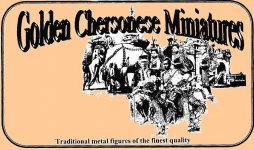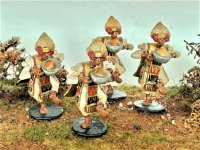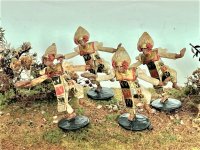Here is the text to the orchestras:
A General Guide To Gamelan Orchestras
Throughout the Indonesian Archipelago, there are many different types of gamelan orchestras which differ as to their composition. Furthermore, the instruments are given names, which are sometimes used too specifically or too broadly, leading to ambiguity and confusion.
This guide serves to simplify the types, terms and composition of the major types of gamelan instruments and to offer suggestions on how the pieces may be represented in a gamelan orchestra. Specifically, this guide focuses on the flat gong, kettledrums and xylophone instruments which are represented by Golden Chersonese Miniatures. It is a working draft based on continual research and discovery, and we would welcome any inputs for future revisions.
Flat gong
The most important instrument is the Gong ageng which is made in different dimensions. We use different gong castings to represent this variation in size. These gongs are hung in various ways on supports (gayor).
Outside of the Kraton (palace) court, Gong ageng supports (gayor) are generally of simpler construction than the ornate court Raffles Gamelan Gong ageng gayor.
These simpler gayor will be featured in
Sets A3 within
Series A Bali. and
Set B3c JAVANESE GAMELAN GENDER WAYANG ORCHESTRA.
Kettledrums
These are suspended singly (kenong or kajar) or in multiples (reyong or boning).
Xylophones
There are only two major types of gamelan orchestras:- Balinese or Javanese. The Balinese gamelan is typified by having the keys of their xylophones suspended over bamboo tubes (gangsa) whereas the Javanese gamelan xylophones have their keys placed on a wooden trough (saron). The gangsa section in gamelan gong kebyar is the largest section, consisting of 13 players.
The gender is found in both Balinese and Javanese gamelan orchestras, and is the main metallophone in wayang kulit gamelan orchestras.
An instrument using wooden keys (gambang kayu) is sometimes found within the gangsa section.
Golden Chersonese Miniatures produces musicians with the following types of mallets:
Round mallet
Padded mallet
Rope-wound mallet
Horn or Wooden mallet
The musicians with the correct mallet should be placed before their respective instruments.
The table below summarises the three main types of flat gongs, kettledrums and xylophones and their common names as used in Balinese and Javanese gamelan orchestras. Where possible, the types and numbers of mallets used are also indicated.
Tabulation on the gangsa and gender instruments and type of mallets
| Balinese
| Javanese
| Mallet
| Numbers
| Remarks
|
Flat Gongs
| | | | | |
Hanging gong
| Gong Ageng
| Gong Ageng
| Round
| 1
| These gongs may be hung singly or with other gongs on a gayor
|
Gong Kempul
| Gong Kempul
| Round
| 1
| | |
Gong Kemong
| Gong Klentong
| Round
| 1
| | |
Horizontal gong
| Gong Kethuk
| Gong Kempyang
| Round
| 1
|
|
Kettledrums
| | | | | |
Single kettledrum
| Kenong
| Kenong
| Rope-wound
| 1
|
|
Kajar
| Kajar
| Rope-wound
| 1
|
| |
Multiple kettledrums
| Reyong
| Bonang
| Rope-wound
| 1-2
| Several Balinese musicians each use 1 Mallet
In Gong Kebyar, a single musician uses 2 Mallets
A single Javanese musician use 2 Mallets
|
Xylophones
| | | | | |
| Gangsa
| Saron
|
|
|
|
Metal keys
| Slenthem 7 keys
|
| Padded
| 1
|
|
Gender Bamboo resonators
| Gender Bamboo resonators
| Padded
| 2
| With/without stool
| |
Ugal (giying) 7-12 keys
|
| Horn
| 2
| stool
| |
Pemade
7-12 keys
| Saron
Bonang Barung
| Horn
| 1
|
| |
Kantilan
7-12 keys
| Saron
Bonang Demang
| Horn
| 1
|
| |
Jegogan
5 keys
|
| Padded
| 1
| stool
| |
Calung(Jublag)
5 keys
|
| Padded
| 1
|
| |
Penyacah
5 keys
|
| Padded
| 1
|
| |
Wooden keys
| Gambang kayu
| Gambang kayu
| Padded
| 1-2
|
|
Golden Chersonese Miniatures produces complete sets of gamelan orchestras which have the basic and correct representation of musical instruments within each type of gamelan. A partial number of musicians are provided for each set. This assumes that, for various performances, not all the musicians are playing at the same time and some musicians are expected to double-up for other musical instruments.
Customers who have purchased any of the boxed gamelan orchestras may wish to add additional musicians to represent a full complement of musicians. The table helps them to identify the suitable musicians holding the correct mallet types and numbers to fill the gap.
Note also that the kendhang drummer may be obtained with one or two kendhang drums. Sometimes only one kendhang drummer is used; at other times, two kendhang drummers play together.
The inclusion of a singer (pesinden) is optional. The pesinden is usually part of a wayang gamelan orchestra.
Similarly, the celempung is an optional instrument in many gamelan orchestras. The celempung features in the fore of a gamelan siteran orchestra.
When ordering these additional musicians, please let us know your preference for a specific painting style, if any. We will entertain requests as we produce musicians to represent the Balinese, Javanese or Javanese Kraton (Solo or Yogya), with no extra charge to the basic cost.
Finally, note that Indonesian gamelans are specifically produced and tuned to either of two scales: slendro or pelog. Many gamelan groups actually lay out two complete sets of instruments for a single performance which may include pieces to be performed in either scale. Thus the more adventurous collector possessing a gamelan orchestra may wish to order another complete set of gamelan orchestra to represent this feast. If so, note that the two sets of instruments are usually placed at right-angles to each other. Then depending on the specific music being played, the same musicians then orientate themselves to the appropriate set of instruments accordingly.






























